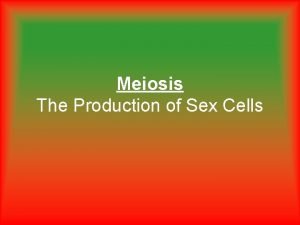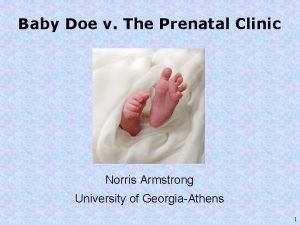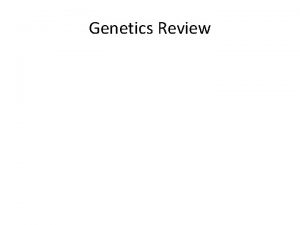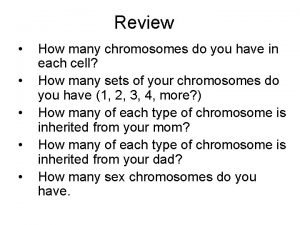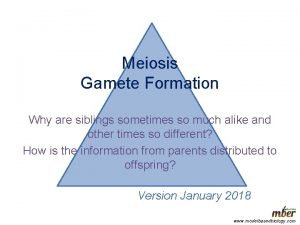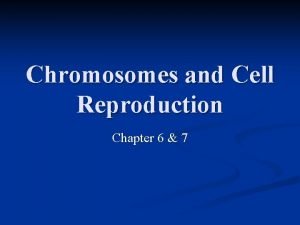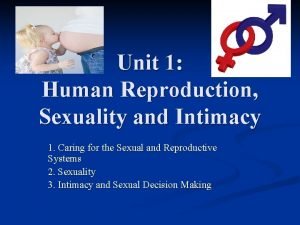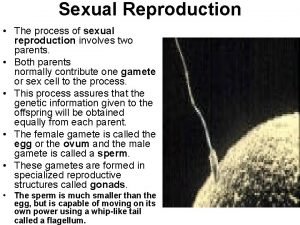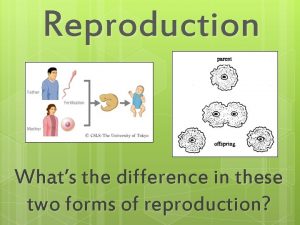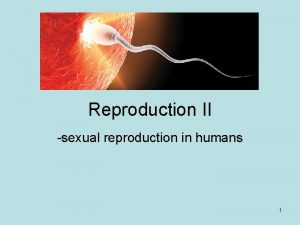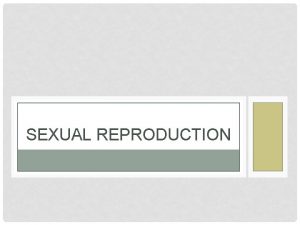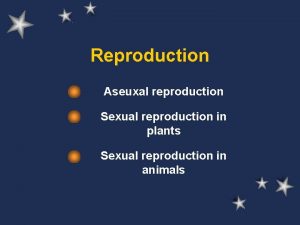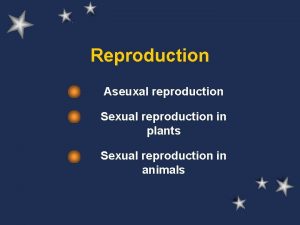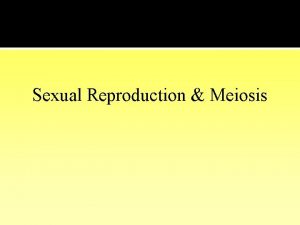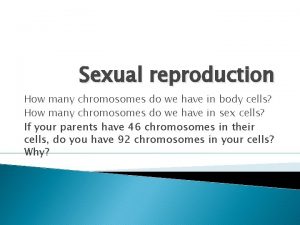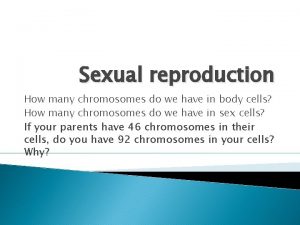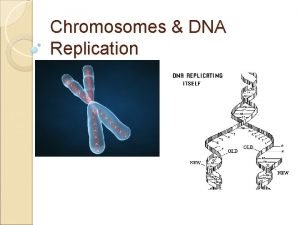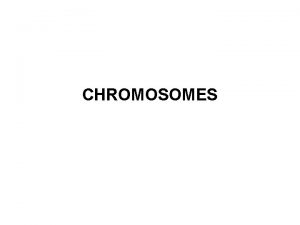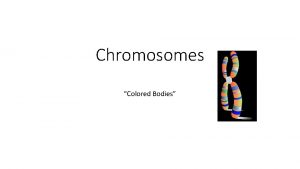Sexual reproduction How many chromosomes do we have
















- Slides: 16

Sexual reproduction How many chromosomes do we have in body cells? How many chromosomes do we have in sex cells? If your parents have 46 chromosomes in their cells, do you have 92 chromosomes in your cells? Why?


Review • Hereditary information is contained in genes, located in the chromosomes of each cell.

Diploid cells • • • Chromosomes come from both the male parent and female parent Homologous: each of the chromosomes coming from one parent have corresponding chromosomes from the other parent Diploid: a cell that contains both sets of homologous chromosomes = “two sets” (2 N) – Diploid cells contain two complete sets of chromosomes and two complete sets of genes – Human somatic (body) cells have 46 chromosomes or 23 homologous pairs

Haploid cells • • Haploid: contain only one set of chromosomes and one set of genes = “one set” (N) Gametes of sexually reproducing organisms are haploid containing one complete sets of chromosomes and one complete sets of genes Human gametes (sex cells) have 23 chromosomes Sperm (23) + Egg (23) = Zygote (46) How are haploid gamete produced from diploid cells? •

Because of MEIOSIS this doubling does not occur and the ZYGOTE (fertilized egg) has the same number of chromosomes as the parent. HOW DOES THIS OCCUR ?

Meiosis The process of reduction division in which the number of chromosomes per cell is cut in half through the separation of homologous chromosomes in a diploid cell

Meiosis consists of 2 phases: ◦ Meiosis II ◦ To begin, you have one diploid cell ◦ In the end, you have four haploid cells Meiosis

Meiosis I • • • Cells begin to divide in a way that looks similar to mitosis Each chromosome pairs with its corresponding homologous chromosome to form a tetrad – there are 4 chromatids in a tetrad The homologous pairs may exchange portions of their chromatids in a process called crossing-over which results in the exchange of alleles between homologous chromosomes and produces new combinations of alleles

Meiosis I Homologous chromosomes separate and two new cells are formed Each new cell has equal numbers of chromatids but neither have the same complete set of chromosomes or alleles as each other or the original diploid cell

Figure 11 -15 Meiosis Section 11 -4 Meiosis I Interphase I Prophase I Metaphase I Anaphase I Cells undergo a round of DNA replication, forming duplicate Chromosomes. Each chromosome pairs with its corresponding homologous chromosome to form a tetrad. Spindle fibers attach to the chromosomes. The fibers pull the homologous chromosomes toward the opposite ends of the cell. Go to Section:

Meiosis II • • • The two cells enter a second meiotic division Neither cell goes through chromosomal replication, so each chromosome has 2 chromatids Pairs of chromatids separate Each daughter cell produced receives equal amounts of chromatids The four daughter cells contain haploid (N) chromosomes

Figure 11 -17 Meiosis II Section 11 -4 Meiosis II Prophase II Metaphase II Meiosis I results in two haploid The chromosomes line up in a (N) daughter cells, each with half similar way to the metaphase the number of chromosomes as stage of mitosis. the original. Go to Section: Anaphase II Telophase II The sister chromatids separate and move toward opposite ends of the cell. Meiosis II results in four haploid (N) daughter cells.

Gamete formation Male: sperm (4 equal sized gametes produced) Female: egg/polar bodies (1 egg cell produced which contains most of the cytoplasm, and 3 polar bodies which are usually not involved in reproduction)

Mitosis vs. Meiosis Mitosis – produces 2 genetically identical diploid cells; ONE division; autosomes (body cells); chromosome # maintained; asexual reprod Meiosis – produces 4 genetically different haploid cells; TWO divisions; gametes (sex cells); chromosome # halved; sexual reprod

MITOSIS VS. MEIOSIS MITOSIS: • THE PROCESS BY WHICH A DIPLOID CELL(2 n) PRODUCES TWO DIPLOID (2 n) CELLS • INCLUDES ONE CELL DIVISION • ASEXUAL REPRODUCTION MEIOSIS: • THE PROCESS BY WHICH A DIPLOID CELL (2 n) PRODUCES FOUR HAPLOID (1 n) CELLS (GAMETES) • INCLUDES TWO CELL DIVISIONS • SEXUAL REPRODUCTION Compare mitosis and meiosis on the graphic organizer with your seat partner…
 Venn diagram of sexual and asexual reproduction
Venn diagram of sexual and asexual reproduction Hare lynx
Hare lynx Venn diagram of sexual and asexual reproduction in animals
Venn diagram of sexual and asexual reproduction in animals 23 chromosome pairs
23 chromosome pairs How many chromosomes do humans have
How many chromosomes do humans have How many chromosomes do humans have
How many chromosomes do humans have How many pairs of chromosomes do humans have? *
How many pairs of chromosomes do humans have? * How many chromosomes do prokaryotes have
How many chromosomes do prokaryotes have How many chromosomes
How many chromosomes Chapter 6 chromosomes and cell reproduction
Chapter 6 chromosomes and cell reproduction A sexual reproduction in humans
A sexual reproduction in humans Sexual reproduction
Sexual reproduction Reproduction explain
Reproduction explain Define sexual reproduction
Define sexual reproduction Sexual reproduction and genetics section 1 meiosis
Sexual reproduction and genetics section 1 meiosis What is reproduction
What is reproduction Sexual reproduction in human
Sexual reproduction in human




